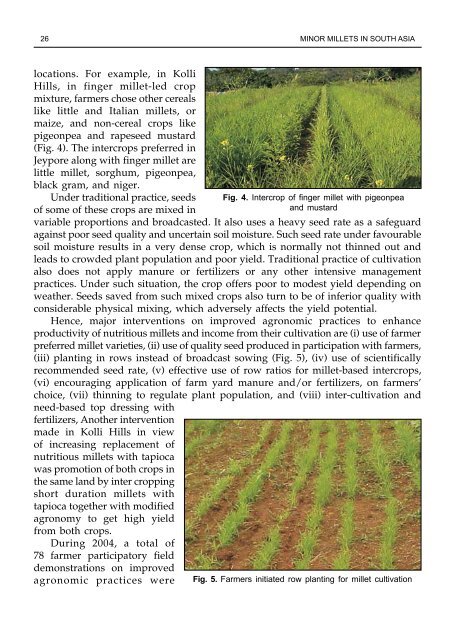Minor millets in South Asia: learnings from IFAD-NUS project in India ...
Minor millets in South Asia: learnings from IFAD-NUS project in India ...
Minor millets in South Asia: learnings from IFAD-NUS project in India ...
You also want an ePaper? Increase the reach of your titles
YUMPU automatically turns print PDFs into web optimized ePapers that Google loves.
26 m<strong>in</strong>or <strong>millets</strong> <strong>in</strong> south asia<br />
locations. For example, <strong>in</strong> Kolli<br />
Hills, <strong>in</strong> f<strong>in</strong>ger millet-led crop<br />
mixture, farmers chose other cereals<br />
like little and Italian <strong>millets</strong>, or<br />
maize, and non-cereal crops like<br />
pigeonpea and rapeseed mustard<br />
(Fig. 4). The <strong>in</strong>tercrops preferred <strong>in</strong><br />
Jeypore along with f<strong>in</strong>ger millet are<br />
little millet, sorghum, pigeonpea,<br />
black gram, and niger.<br />
Under traditional practice, seeds<br />
of some of these crops are mixed <strong>in</strong><br />
variable proportions and broadcasted. It also uses a heavy seed rate as a safeguard<br />
aga<strong>in</strong>st poor seed quality and uncerta<strong>in</strong> soil moisture. Such seed rate under favourable<br />
soil moisture results <strong>in</strong> a very dense crop, which is normally not th<strong>in</strong>ned out and<br />
leads to crowded plant population and poor yield. Traditional practice of cultivation<br />
also does not apply manure or fertilizers or any other <strong>in</strong>tensive management<br />
practices. Under such situation, the crop offers poor to modest yield depend<strong>in</strong>g on<br />
weather. Seeds saved <strong>from</strong> such mixed crops also turn to be of <strong>in</strong>ferior quality with<br />
considerable physical mix<strong>in</strong>g, which adversely affects the yield potential.<br />
Hence, major <strong>in</strong>terventions on improved agronomic practices to enhance<br />
productivity of nutritious <strong>millets</strong> and <strong>in</strong>come <strong>from</strong> their cultivation are (i) use of farmer<br />
preferred millet varieties, (ii) use of quality seed produced <strong>in</strong> participation with farmers,<br />
(iii) plant<strong>in</strong>g <strong>in</strong> rows <strong>in</strong>stead of broadcast sow<strong>in</strong>g (Fig. 5), (iv) use of scientifically<br />
recommended seed rate, (v) effective use of row ratios for millet-based <strong>in</strong>tercrops,<br />
(vi) encourag<strong>in</strong>g application of farm yard manure and/or fertilizers, on farmers’<br />
choice, (vii) th<strong>in</strong>n<strong>in</strong>g to regulate plant population, and (viii) <strong>in</strong>ter-cultivation and<br />
need-based top dress<strong>in</strong>g with<br />
fertilizers, Another <strong>in</strong>tervention<br />
made <strong>in</strong> Kolli Hills <strong>in</strong> view<br />
of <strong>in</strong>creas<strong>in</strong>g replacement of<br />
nutritious <strong>millets</strong> with tapioca<br />
was promotion of both crops <strong>in</strong><br />
the same land by <strong>in</strong>ter cropp<strong>in</strong>g<br />
short duration <strong>millets</strong> with<br />
tapioca together with modified<br />
agronomy to get high yield<br />
<strong>from</strong> both crops.<br />
Dur<strong>in</strong>g 2004, a total of<br />
78 farmer participatory field<br />
demonstrations on improved<br />
agronomic practices were<br />
Fig. 4. Intercrop of f<strong>in</strong>ger millet with pigeonpea<br />
and mustard<br />
Fig. 5. Farmers <strong>in</strong>itiated row plant<strong>in</strong>g for millet cultivation

















